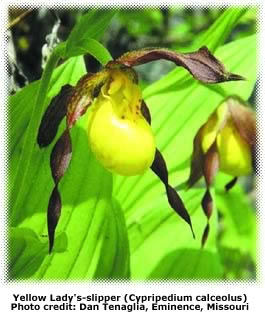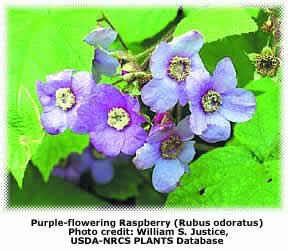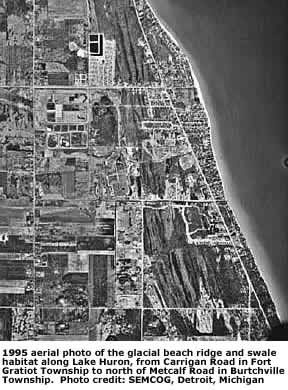Between the big western ridge and Lake Huron are smaller ridges and swales. Widths range from about 10 feet to a few hundred feet. The most well-defined are in Fort Gratiot and Burtchville Townships in Saint Clair County. On aerial photographs, ridges and swales stand out as a mile-wide band of alternating light and dark lines paralleling Lake Huron, tightly packed in some areas like grooves on a record disk. The right needle could play an ancient lakeshore tune. The lighter areas on the photographs are sand ridges. The dark strips between are muck-filled wetland swales. Muck is a black organic soil consisting of nearly pure carbon, the accumulation of centuries of plant material decomposed in shallow water.
A huge muck area also formed west of the big beach ridge at the western edge of the habitat. Much of it drained by the early 1900s, it was so good for farming that the area around the Fort Gratiot Township hall and east along Keewahdin Road became known as "Gardendale". But, the area was still wet enough that older residents recall a time when tree trunks were placed in the road every spring to allow travel.

Although impacted by sand and muck mining, livestock grazing, and development, much of the habitat remains intact and largely forested. Walking along the dry sand crests of the higher ridges, a person finds themselves amongst Red Oak, Black Cherry, Quaking Aspen, and Paper Birch. Several feet below are muck swamp of Silver Maple and Green Ash. Further north in Burtchville Township and Sanilac County, northern Michigan species like Northern White-cedar, Eastern Hemlock, and Yellow Birch become more prominent. Subtle blends of muck, sand, and water, combined with a cooler growing season along Lake Huron provides habitat for plant species that occur in few other parts of Michigan. The habitat contains uncommon species like Purple-flowering Raspberry, and orchids like Yellow Lady's-slipper.
Purple-flowering Raspberry (Rubus odoratus) is a striking plant, with large maple-shaped leaves and large rosey-purple flower petals with pastel yellow centers. The species is thought to be native to only 7 shoreline counties in Michigan along Lake Huron and Lake Erie, including Saint Clair and Sanilac. In the Thumb, it grows only in the glacial ridge and swale habitat. Purple-flowering Raspberry is closely related to Thimbleberry (Rubus parviflorus), well known in Michigan's upper peninsula for Thimbleberry jam.

The coastal forest of the glacial beach ridge and swale landscape is very important for migratory birds that move north and south along Lake Huron, supporting an abundance of warblers and other woodland birds. The Eastern Hognose Snake, usually a dune inhabitant in Michigan, and with the unusual habit of puffing up its neck like a cobra when disturbed (but otherwise harmless), is also known from this habitat.
There never was much of this glacial beach ridge and swale habitat in Michigan. In the Thumb, it covers less than 1% of the landscape in a narrow band from Port Huron through Lakeport State Park, a thin strip north of Forester, and not much else. Unfortunately, very little attention has been given to the habitat in the Thumb. Since the early 1990s, large areas have been destroyed by development, especially within the commercial strip in Fort Gratiot Township. Hopefully, as awareness of this unique landscape increases, appreciation for it will grow.
This Article Opened In A New Window. Close This Window When Finished
